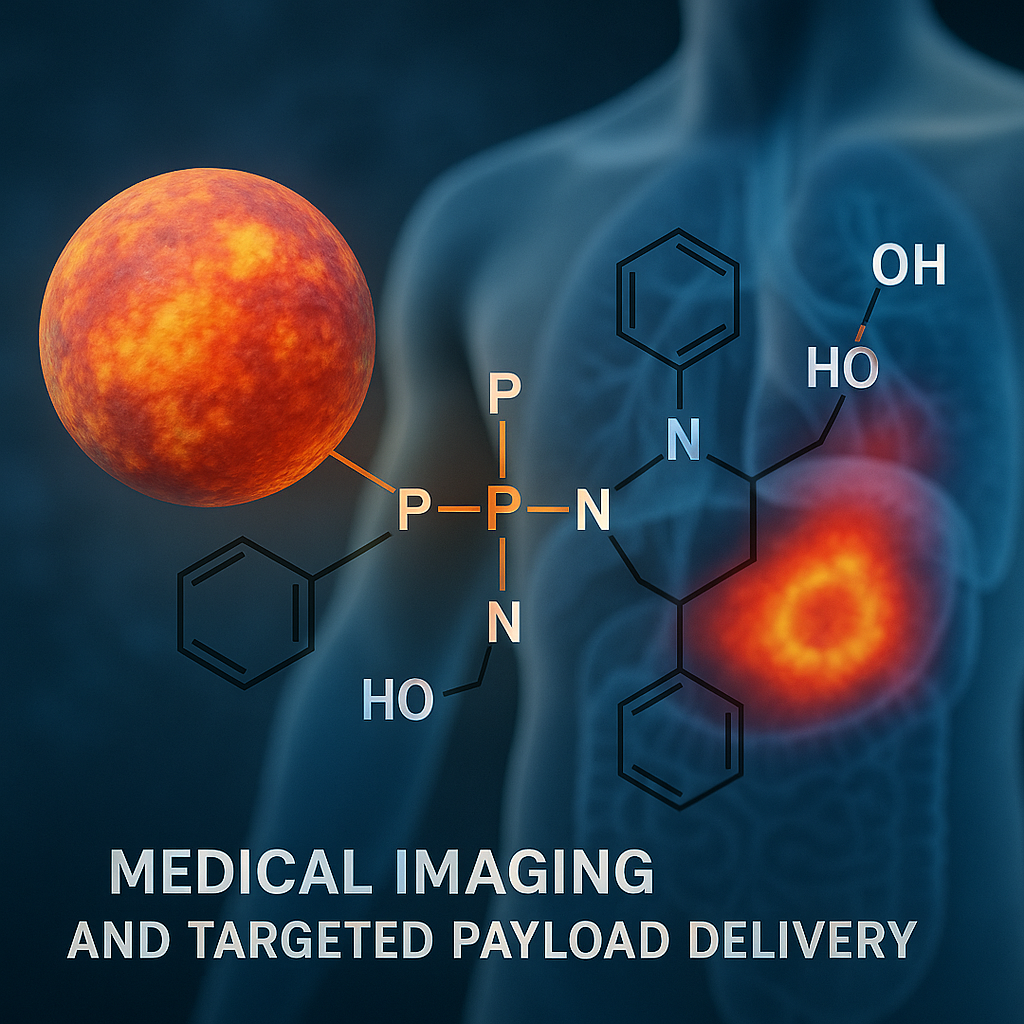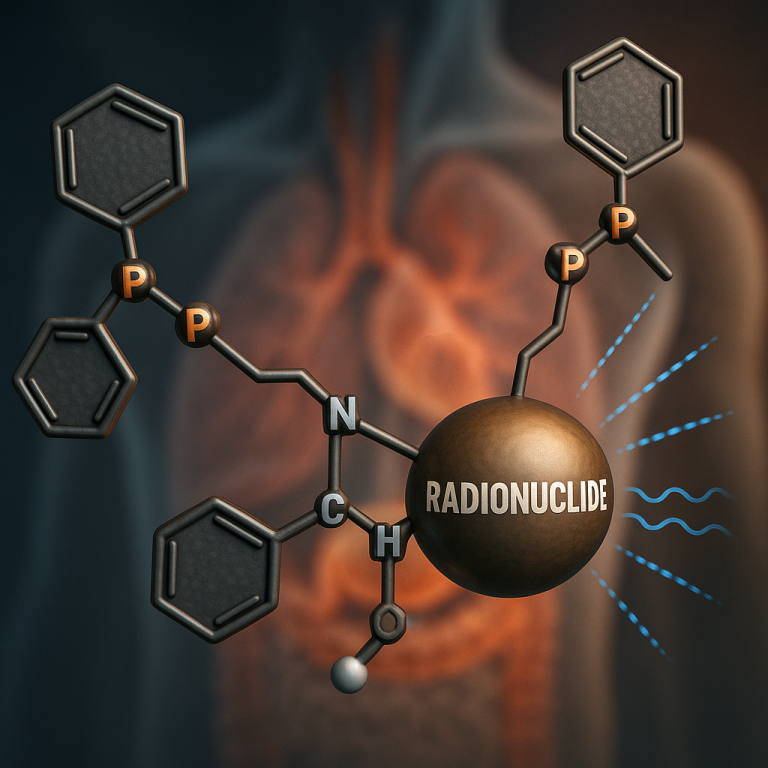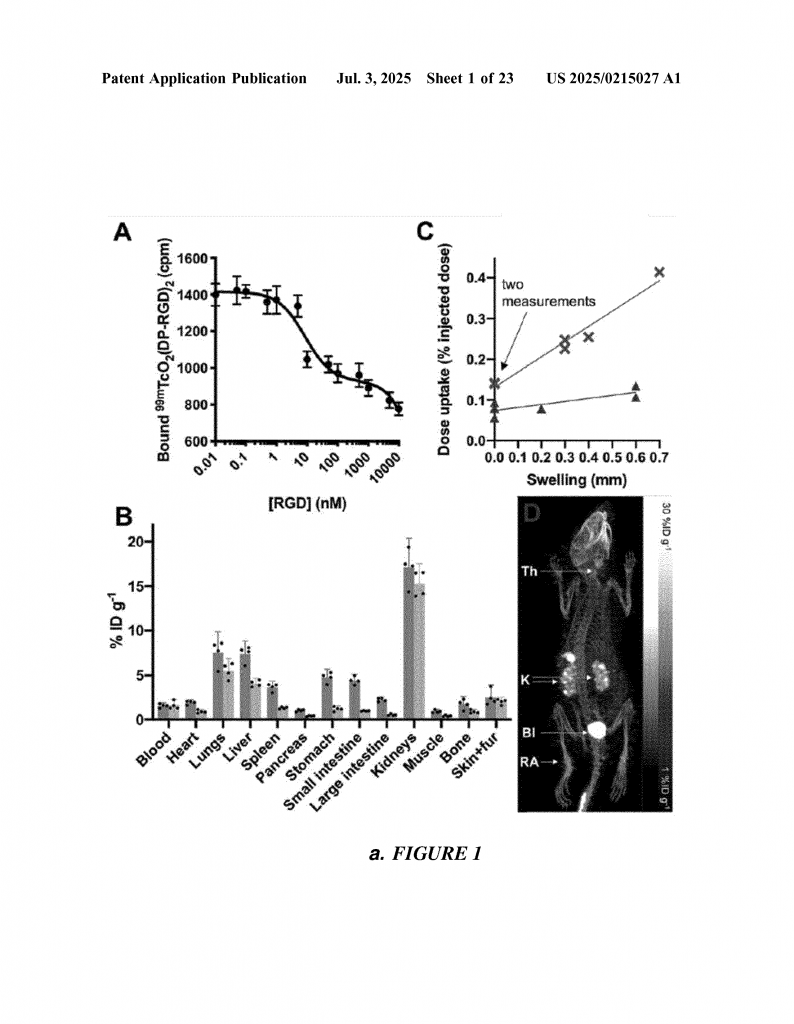DIPHOSPHINE COMPOUNDS AND COMPLEXES

Invented by Ma; Michelle Therese, Hungnes; Ingebjorg Narvestad, Rivas; Charlotte, Pham; Truc Thuy, Pringle; Paul Gerard, Nuttall; Rachel Elizabeth, Cancer Research Technology Limited

Welcome! Today, we’re going to walk through a groundbreaking patent application that could transform how doctors see and treat diseases like cancer and arthritis. This invention is about new chemical compounds that make it much easier to prepare radiolabelled medicines—right at a hospital—using a simple kit. These new compounds help doctors target diseases more precisely, use widely available equipment, and improve patient care. Let’s break down what this means, why it’s important, and how it works.
Background and Market Context
To understand this invention, let’s start with the big picture: how doctors use special “radiolabelled” chemicals to look at diseases inside the body and sometimes treat them, too.
Doctors use machines called SPECT and PET scanners to see inside the body. These scanners track tiny amounts of radioactive medicine that doctors inject into a patient’s blood. Where the medicine goes tells the doctor a lot about what’s happening inside—like if there’s cancer, how big it is, or how the body’s organs are working.
SPECT scanners are very common in hospitals around the world. They use radioactive atoms like technetium-99m (“99mTc”), which are easy to get, not too expensive, and last long enough to be used in clinics. PET scanners are newer and can be even more sensitive and detailed, but they need special equipment and their radioactive atoms don’t last as long. In many places, SPECT scanners are still the main tool for this kind of imaging.
Each year, doctors use SPECT scans more than twice as often as PET scans. That’s because SPECT machines are everywhere, the radioactive materials are easier to get, and the cost is lower.
But there’s a problem. While the equipment and radioactive atoms for SPECT are everywhere, the chemistry used to make these special medicines hasn’t changed much in the last 20 years. The old methods are simple, but they don’t let doctors target diseases at a molecular level. The most common SPECT drugs can’t be attached to the kinds of molecules—like peptides and proteins—that stick to specific disease targets. That means doctors can’t always see exactly where the disease is or deliver treatment just to sick cells.
Researchers have been trying to fix this. They want “kit-based” radiopharmaceuticals that can attach to targeting molecules and be made right in the clinic. Why? Because if you can mix everything together in one step, in one vial, and get a drug that sticks only to the disease, it’s safer, faster, and can be done almost anywhere. It would open up advanced imaging and treatment to millions more patients.

That’s what this patent is all about: a new chemical platform that lets doctors, nurses, or pharmacists easily make targeted radiolabelled medicines using simple, widely available kits. The core of this idea is a new kind of “diphosphine” molecule that acts like a bridge between the radioactive atom and the disease-targeting agent.
With this new invention, the hope is that hospitals and clinics can quickly and safely prepare targeted radiolabelled compounds on demand, even in places without access to advanced chemistry labs. This could make advanced diagnosis and treatment more available than ever before.
Scientific Rationale and Prior Art
Let’s explore why these new diphosphine compounds matter, how they work, and what makes them different from what came before.
First, some basics: to use a radioactive atom for imaging or therapy, you need a way to hold onto it tightly. That’s where “chelators” come in. A chelator is like a tiny claw that grabs the radioactive atom and keeps it from floating away inside the body. But for modern medicine, it’s not enough to just hold the atom—you also want to guide it to the right spot in the body. That means attaching the chelator to a targeting molecule, like a peptide, that will seek out cancer cells or inflamed tissue.
The most common SPECT chelator, called tetrofosmin, is great at grabbing technetium-99m. It’s used all over the world for heart scans. But it can’t be attached to peptides or proteins. That limits what doctors can do with it. Other chelators for SPECT have similar problems: they’re not easily linked to targeting molecules.
Some researchers have tried to make chelators that can be attached to peptides. For example, compounds called “bis(diphosphino)maleic anhydride” or “bidentate diphosphines” have been tested. But these early versions mostly used simple “diphenylphosphine” groups and didn’t offer much flexibility. They also didn’t explore the idea of changing the “arms” of the diphosphine to make the chemistry work better or to help the compound dissolve in the body.
Other patents mention using nitrogen-based chelators or different ways to stick the radioactive atom to a targeting molecule. But these methods don’t use the diphosphine structure, which can offer advantages in stability, ease of synthesis, and the ability to fine-tune the properties of the final compound.

What this patent does differently is introduce a customizable diphosphine platform. The inventors realized that by changing the “arms” of the diphosphine—by adding different chemical groups—they could make the radiolabelling step work faster, under milder conditions, and with higher yields. They could also control how the compound behaves in the body, tweaking how quickly it’s cleared or how tightly it sticks to disease targets.
Even more, this patent shows that you can make these compounds in a way that’s compatible with simple kit-based preparation. That means you just mix the right powders, add the radioactive atom, and get the medicine—without fancy lab equipment. The compounds are stable, can be stored as kits at low temperatures, and work with a wide variety of targeting molecules, including peptides that stick to prostate cancer, inflammatory cells, or bone.
This approach builds on the old chemistry but makes it much more flexible and practical for real-world use. It opens the door to one-step, clinic-ready radiopharmaceuticals that can be made anywhere, with high reliability and specificity.
Invention Description and Key Innovations
Now, let’s dive into the heart of the invention: what exactly are these new compounds, how are they made, how do they work, and what makes them special?
At its core, this invention is about a new family of “conjugated diphosphine precursor compounds.” Don’t let the big words scare you! Think of them as smart connectors: on one end, they grab a radioactive atom; on the other, they stick to a targeting molecule. In the middle, there’s a customizable part that controls how the whole thing behaves.
Here’s how it works:
The new diphosphine compounds have two “phosphine” groups (the claws for grabbing the radioactive atom) joined by a special ring in the middle. This ring can be opened up and linked to a targeting molecule—like a peptide that sticks to prostate cancer cells, or a molecule that binds to bone, or even a sugar that finds inflammation.

The key innovation is the ability to change the “arms” of the diphosphine (called X1, X2, X3, X4 in the patent) by adding different chemical groups. These groups can be simple things like methyl or methoxy, or longer chains, or even groups that make the compound more water-loving (hydrophilic) or fat-loving (hydrophobic). By picking the right combination, you can make the final medicine dissolve better in the body, stick better to its target, or clear out of the body at the right speed.
The patent covers many different versions of these compounds, with options to attach various targeting ligands. Some of the main targeting molecules described include:
- PSMA-targeting peptides for prostate cancer
- RGD peptides that stick to blood vessels in tumors or inflamed joints
- Pentixafor peptides for inflammation
- Minigastrin analogues for certain stomach cancers
- Bisphosphonates for bone diseases
- Folate and carbohydrates for other types of cancer or inflammation
These diphosphine compounds can be radiolabelled with a variety of radioactive atoms, including technetium-99m (for imaging), rhenium-186 and rhenium-188 (for therapy), and copper isotopes (for both). The radiolabelling can be done in one step using a kit, with all the needed chemicals already included. Just add the radioactive atom, mix, and you’re ready to go—no need for advanced chemistry skills.
The patent also describes the exact methods for making these compounds, right down to the details about which solvents, temperatures, and catalysts to use. This is important, because it means the process can be repeated easily in many different settings. The compounds are stable enough to be stored as freeze-dried kits, ready for use whenever needed.
One of the most clever aspects is that the final radiolabelled complex actually holds two copies of the targeting ligand. This “double dose” increases the chance that the medicine will find and stick to its target, improving uptake in tumors or areas of disease. It also means that even if there’s some extra ligand floating around, it doesn’t get in the way.
The inventors tested these compounds in real biological settings. They showed that the radiolabelled complexes find their targets in cell cultures and in mice, stick where they’re supposed to, and clear out of the body in a predictable way—usually through the kidneys, which is desirable for imaging agents. The compounds are stable in the blood and don’t break down quickly, which is important for safety and accuracy.
The patent covers not just the compounds and kits, but also pharmaceutical formulations, and even the use of these compounds in treating or diagnosing diseases. That means the platform is ready for use in clinics, hospitals, and research labs.
Here’s why this invention is a game-changer:
- It lets doctors and pharmacists make targeted radiolabelled medicines using simple kits, right at the hospital.
- The chemistry is flexible, so you can adapt it to many different diseases and targeting molecules.
- The process works under mild conditions—no need for high temperatures or fancy equipment.
- The compounds are stable, safe, and clear from the body in a predictable way.
- The same platform works for imaging and for therapy, making it easier to personalize treatment for each patient.
Conclusion
This patent brings a powerful new tool to hospitals and clinics everywhere. By redesigning the core chemistry of radiolabelled medicines, the inventors have made it possible to prepare advanced, targeted drugs using reliable, easy-to-use kits. This innovation takes advantage of the SPECT imaging infrastructure already in place worldwide and opens the door to more precise diagnosis and therapy for cancer, arthritis, and other diseases.
If you’re a doctor, pharmacist, or healthcare provider, this means you could soon have access to better tools for seeing and treating disease—without waiting for specialized equipment or long supply chains. If you’re a patient, it means more accurate diagnosis, safer tests, and the possibility of more personalized, effective treatments.
As the medical world moves toward more personalized care, inventions like this one will play a big role. By making advanced radiopharmaceuticals simple, flexible, and widely available, this patent has the potential to change the landscape of disease diagnosis and treatment for years to come.
Click here https://ppubs.uspto.gov/pubwebapp/ and search 20250215027.


